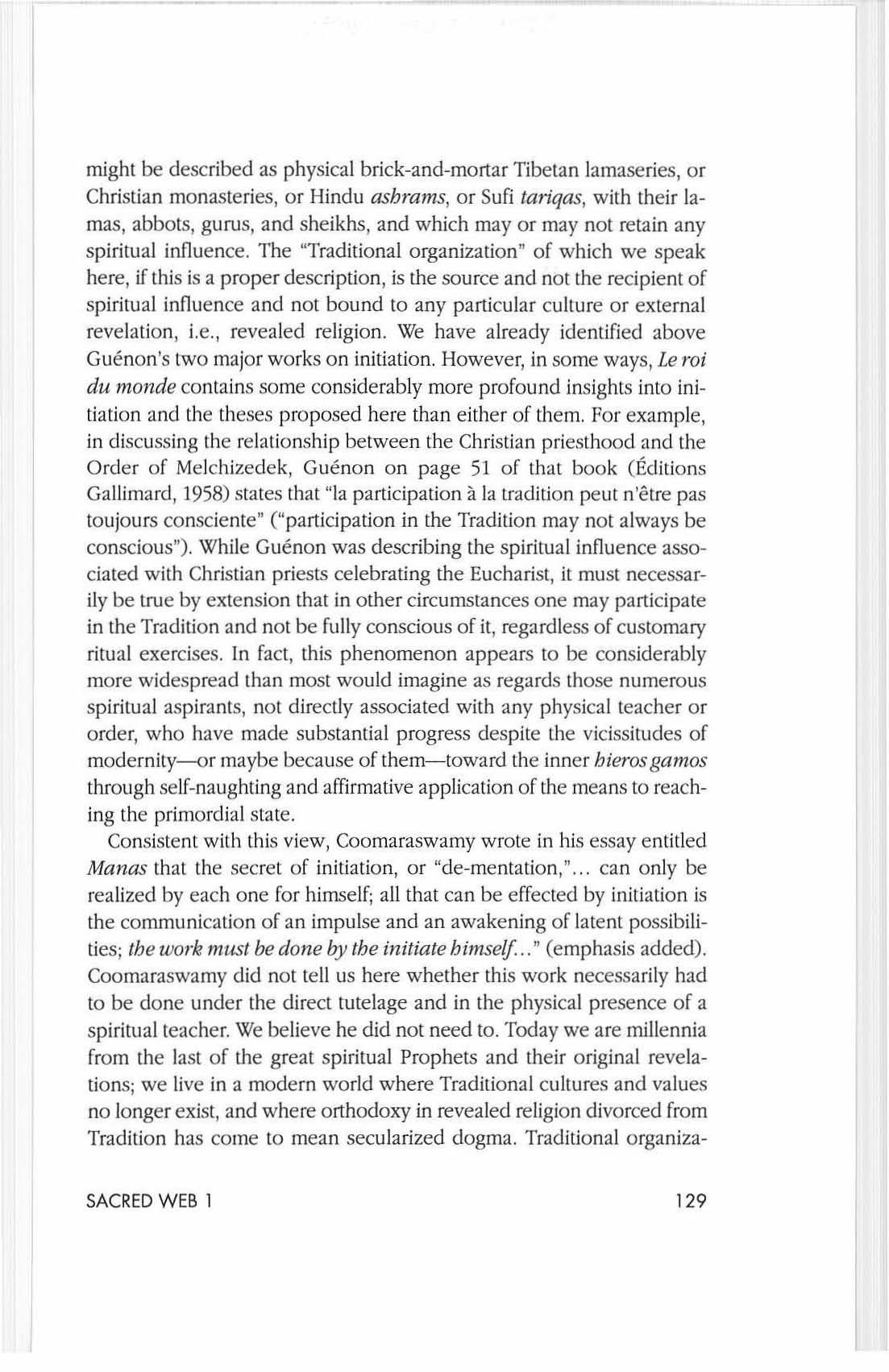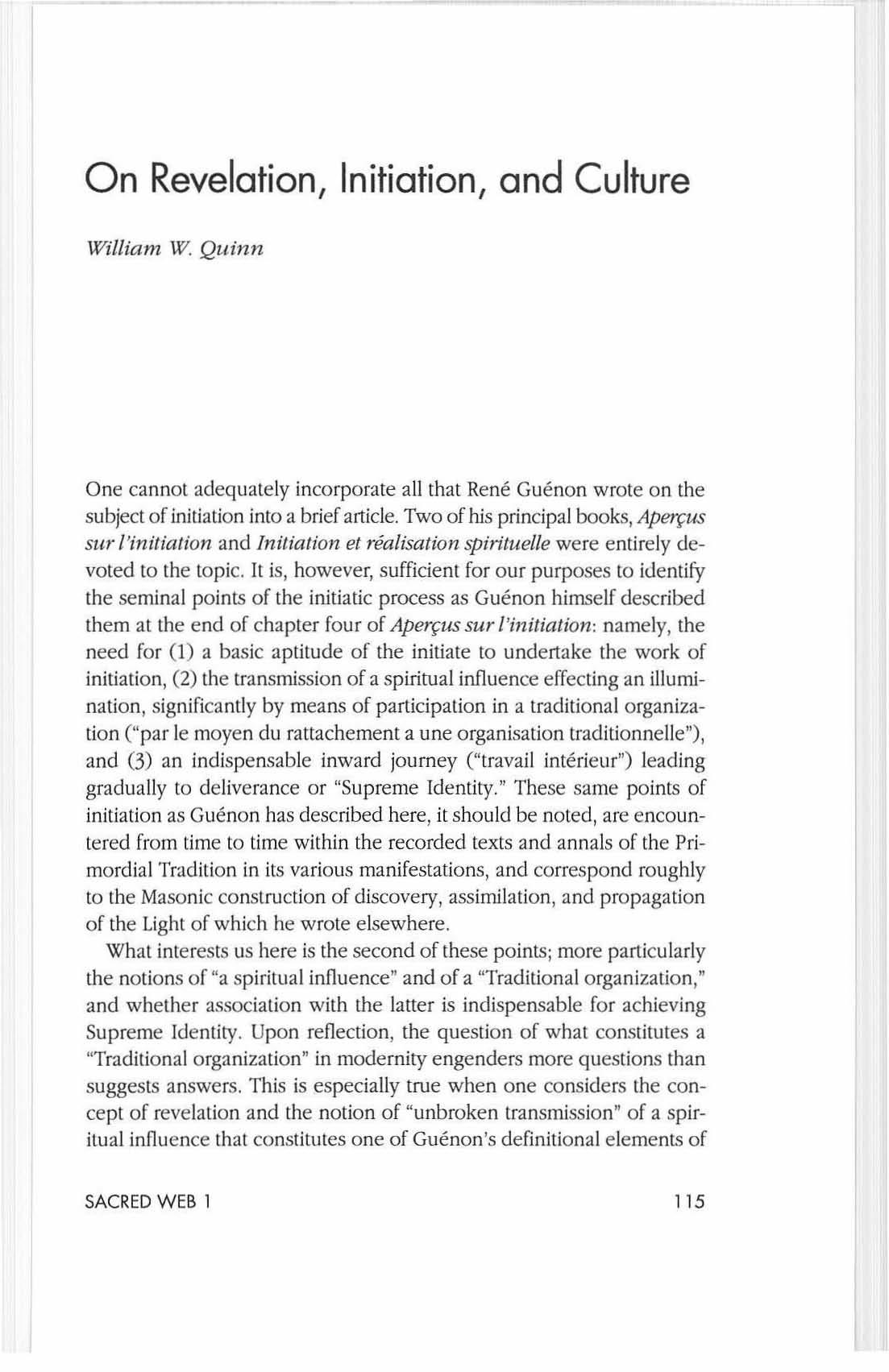
36 minute read
On Revelation, Initiation, and Culture
from Sacred Web 1
William W. Quinn
One cannot adequately in co rporate all that Rene Guenon wrote o n the subject of initiation into a brief article. Two of his principal books, Apelfus sur "initiation and Initiation el realisation spirituelle were en tir ely devoted to the lOpic It is, however, sufficient for our purposes to itlentify the se minal points of th e in iti atic process as Guenon hims elf described t hem at th e e nd of c h apter four of ApeYfus sur [ 'initiation: namely, the need for (1) a basic apti tu de of the initiate to undertake the work of initiation, (2) the transmission of a sp ir itual influence e ffe cting an illumination, significan tly by means of participation in a traditiona l orga nization ("par Ie moyen du rattachement a une organisation lraditionnelle"), and (3) an indispensab le in ward journey ("travail interieur") leading grad u a ll y to deliverance or "Sup reme Identity. " The se sa me points of initiation as Gue non ha s descri bed here, it s hould be noted, are encountered from time to time w ithin the recorded texts and anna ls of the Primordia l Tradition in its various manifestations, and correspond rough ly to the Masonic construclion of discovery, assimilation, and propagation of th e Light of which he wrote elsewhere.
Advertisement
What inte rests u s here is the second of these pOints; mor e particularly the notions of "a s piritual influ e nc e" and of a "Traditional o rganizati o n ," and whether assoc iation w ith the latter is indi spe nsabl e for achieving Supreme Id ent ity. Upo n reflection , the qu es ti on of what co nst itut es a "Traditional organization" in modernity engenders more questions than suggests answers. This is especially true when o n e co nsid e rs th e concept of revela ti on and the notion of "u nbroken tran smissio n " of a spi ritual influence that const itutes one o f Guenon's definit iona l elements of
Traditional organization. Moreover, Guenon spoke of the "regular" initi at ion-as di stinc t from "irregu lar"-a nd ne cessarily implied thereby that, like the initiations offered, o rganizations offering initiation were either "regular," e.g., Traditional, or "irregu lar," e.g., pseudo-esoteric, th e latter be ing perfectly illustrative of the cris is of the modern world and the signs of the times. Among our principal objectives here is to examine what is, in fact , a "Traditional o rganizati on, " w hat gives one its authenticiry, and whe ther it is a sine qua non for such an organization to ha ve link s to an orthodox branch of one of the major world re ligions in which some form of succession or transmission may exist.
Ananda Coomaraswamy was a good deal more circumspect about initiation than was Gue non. Most of Coomaraswamy 's wri ting s on initiation, like his article titl ed "The ' E' at Delphi," conce rned the initialic aspeclS of what surv ives to us of ancient and mediaeval Traditional cultures in scriptura l or iconographic form. To say this is not to suggest that initiation to Coomaraswamy was not an in tegral part of the spiritual quest or not an endem ic principle of the ph ilosophia perennis. Rather, it is to say that the emphasis placed on it by Cooma ra swamy was both less and differe nt than that placed on it by Guenon for whom, as Gabriel Asfar comme nted , initiati o n was a "sac ram e nt. " Furth er, to observe this differe n ce in the ways these two men approached th e su bject of iniliati on is not to suggest th eir views were in co nflict or di.s...<;imilar. This difference of emp h asis , in stead, provides a useful heuristic device for purposes of exami ning the broad topic of the relationship between initiation and cu lture , and all related considerations implicated by this topic h is necessary, at this point, to define two terms that are used throughout. The first is "Traditional culture," by which we mean a society in which th e first principles of the Trad ilion hav e an overt and preeminent role in the life a nd morphology of the cu lture; where the s tat e religion, as it were, reflects in its scripture and sy mboli s m those first principles; where the social order is hierarchica lly arranged with the spiritual-metaphysical-component (Guenon 's "spiritual elecl ") at the top; where all vocation a t every level reflects the Tradition and provides an opportunity for tho se who merit to access truth an d undergo initiation; and where these cult ural e le ments are unanimous, wholly sys temic , and consequently it"ving. Th e seco nd term n eeding definiti o n is "orthodoxy," a concept having spec ial meaning in Traditional literature and which of- ten leads t hose n ewly co me to Traditional sou rces int o some confusion and ambiguity. The prescr ip tive usage is easy enough to comprehend, fro m the Gree k ol1b os, mea nin g "s traight " or "reg ul ar," (from th e IndoEuropea n root werdh "to grow " (st raight) , from w hence th e Sans krit vardhati) , combi ne d with doxa ("o pini o n ") from t he verb dokein ("to think "), resu lti ng in "s tr aigh t thinking ," or "to think strai g h t." The d esc riptiv e usage, on th e other hand , aligns orthodoxy with eccl es ia stica l a u t hority and d og ma, so that whether a requir e d belief is true (straight) or not , one mu s t accept it as s u c h or risk the consequences. In thi s definition , th e antonym to o rth o doxy is "he resy" or as often "h e terodox," as against "un o rthod o x ." The obvious problem with the definition of o rth odoxy as it applies to Traditiona l lite rature is that, ove r time, establi s hed eccles ias tical d oc trin e and dogma frequently ca me to serve a nd preserve th e exclu s ive ly sec ul ar e nds of established churches a nd churc h leaders. Sim p ly put , in thi s usage orthodoxy and dogma further the goals of the O ut e r Man among ecclesiastical bureau c ra ts, and no t th e Inn er Man among the ge nuin e s p iritu a l aspirants of t he es tab li s he d c hurc h Anyone famili a r with th e profo und eso te ri c imparl of t he tex ts of 3rd and 4th -ce ntury Med iterra nea n Gnosticism , a "heresy" exp ress ly ta rgeted by th e esta bli s he d c hurch, w ill at once recognize th e problem. W hat is at times unclear a nd thus problematic in the w ritin gs o f ce rt a in Traditional authors, includ in g Gu e non , is whether "o rthodoxy " is being use d in the prescripti ve or d escrip tiv e se nse or in so me o th e r se nse a ltoget her in discussing t ransmission, s uc cess ion , and initiatio n in Traditi o nal organizations. 1
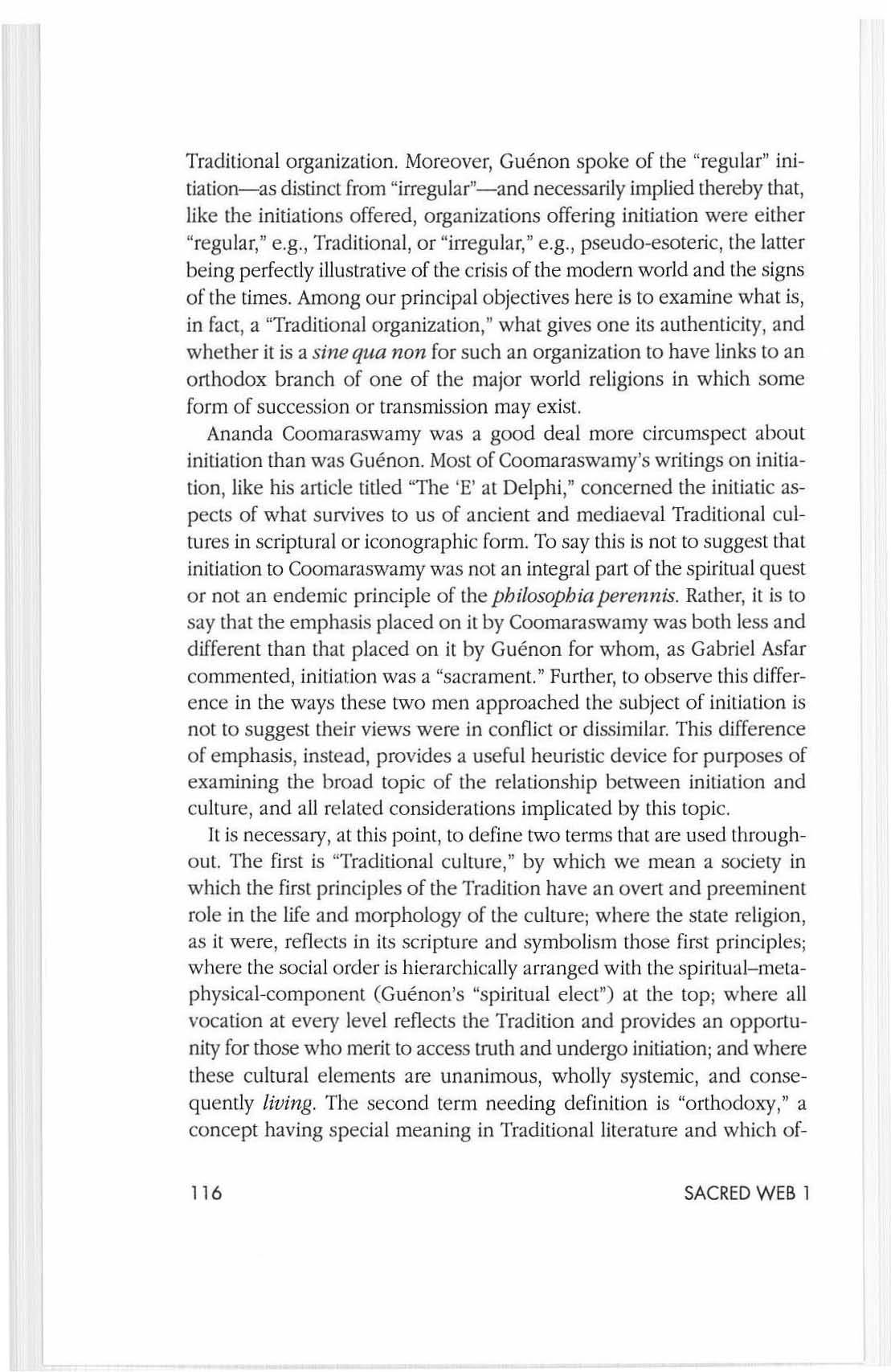
External Revelation
The Prim o rdi a l Tradition, which is the so ur ce of a ll traditions, is time- less and immemorial and uncond iti oned. The s pecifi c traditions, however, which are a lways associated with cu ltures-or "soc ielies" if o ne prefers--come and go like sen ti e nt beings. Eac h has a paint of orig in in history, usually associated with an externa lly manifested revelation, and lives a cycle of growth, maturity , decrepitude, and death. This process occurs both in tandem with, and regardless of, th e larger cycles at work in th e cosmos associated with the Ind ic notion of yugas. Leaving aside triba l or "primitive " soc ie tie s, which typically are every bit as trad iti onal as tho se most fam iliar to us, like the India of Sankara for examp le, one can trace this process as among c ultur es informed by th e major world religions quite easily simp ly by referring to the lists of former Tradit io nal cultures publisheJ by both Coomaraswamy and Guenon. Those listed cultures no longer exist in the late twenrieth century--each li ved its life and died , as it were. Today, in the wake of the ravages and viciss itudes of modernity, one cannot point to a single unspoiled and tndy li ving Traditional culture informed by a major world religion anywhere on the planet, and perhaps on ly to a handfu l of surviving pri stine, triba l societies in the remotest regions of the Earth.
1. Con founding this i<;sue even mo re is Guenon's use of the term ort hod oxy" in c hapter 13 of Flmdmnenlal Symbols (Quinta Essentia 1995), which we use in p refe re nce to Ed itions Gallimard 1962 beca use of the ed itor's footnote 13 "Tt'aditional as used h ere by Guenon means-assuming it is not e tymolog ically redundant -a com munication &between and participati o n in the attributes of th e Centre of the World & and a given Traditional religion / culture. lnc editor's extenuat ion of Gucnon's s ta tement both (1) confirms th e view that a cessation o f the maintenance o f thiS dir<-"t co mmu nication results in the demise o f its o rth od oxy and, in the process, (2) blurs the distinctio n be tween usage and meaning of the term s "o rthodoxy" and "spiritual innuc nce (and the transmi ssion thereof), by making them pr:lclically interchangeable.
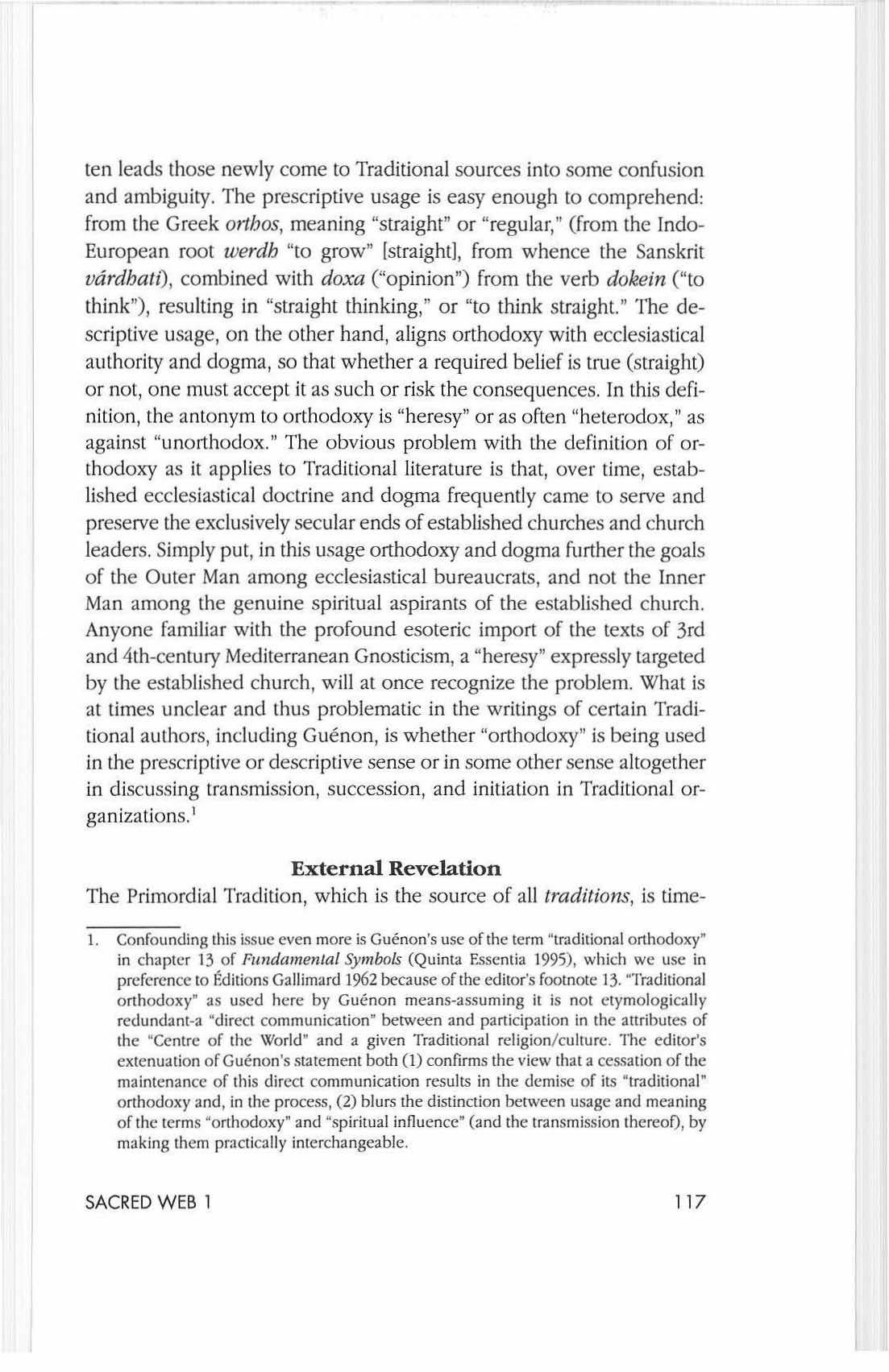
It is critica l in making such observations to di stinguis h unanimous and living Traditiona l cultures roote d in the sacred Primordial Tradition-whether th ey were Christian or Islamic or Hindu or Buddhistand cultures that may be predominantly Ch ri stia n or Islamic or Hindu or Buddhist in modernity. The latter a re now all modern nations and creatures of modernity. Though the re li gious dimensions may be more or less infu sed into the fabr ic of their polities, one does not find among them any genuine Traditional cult ures fitt ing the definition set forth supra. As to the former, however, one can identify in each a period of maturity-by which we mean a spiritual maturity-where unanimity and the exp licit assimi lation of th e firs t pr incip les of the Tradition were predominant charac teristics. Conversely, in modern times th e critical unanimity of formerly Tradi tional cu ltures has g iven way to a confusion of languages, ethnicilies, global socialization, p olitica l rivalries, secularization, industriali za tion and pollution, sectarian and fundamenta li st re li gious tendenci es, and ot her simi lar constituents of d isintegration, th ereby precluding any possible reinstatement of Tra ditional cultu re .
The typica l pOint of origin o f any developed Traditional culture was a public and external revelation , more or less encapsulated by the San- skrit term Sruti. This may be sa id of Moses for Judaism, Lao-tzu for Taoism, th e Buddha for Buddhism, Jesus for Christianity, and Muhammad for Islam. While agree ing with Coomaraswamy that each ought to be afforded the higher d ignity of a mythical rea lity, there is nonetheless some historicity involved wi th these prophets-these avatalS-who came to humanity with the purpose of bringing Light , literally a revelation in a world of darkness. So , it ca n be said, for examp le , that in 569 C.E., a year before the birth of Muhammad, there were no Islami c Traditional c ultures. Such cu lture s that were later to be developed owed their ex istence to the external rev e lati o n brought by the Prophet, who by his existence c hang ed ent ire ly the landscape of polytheistic western Arabia , ju s t as the existing Jewi s h c ulture of Hellenisti c Pal est ine was changed by Jesus , and the existi ng Brahmanic culture of nonhern India was c hanged by the Buddha , and so on.
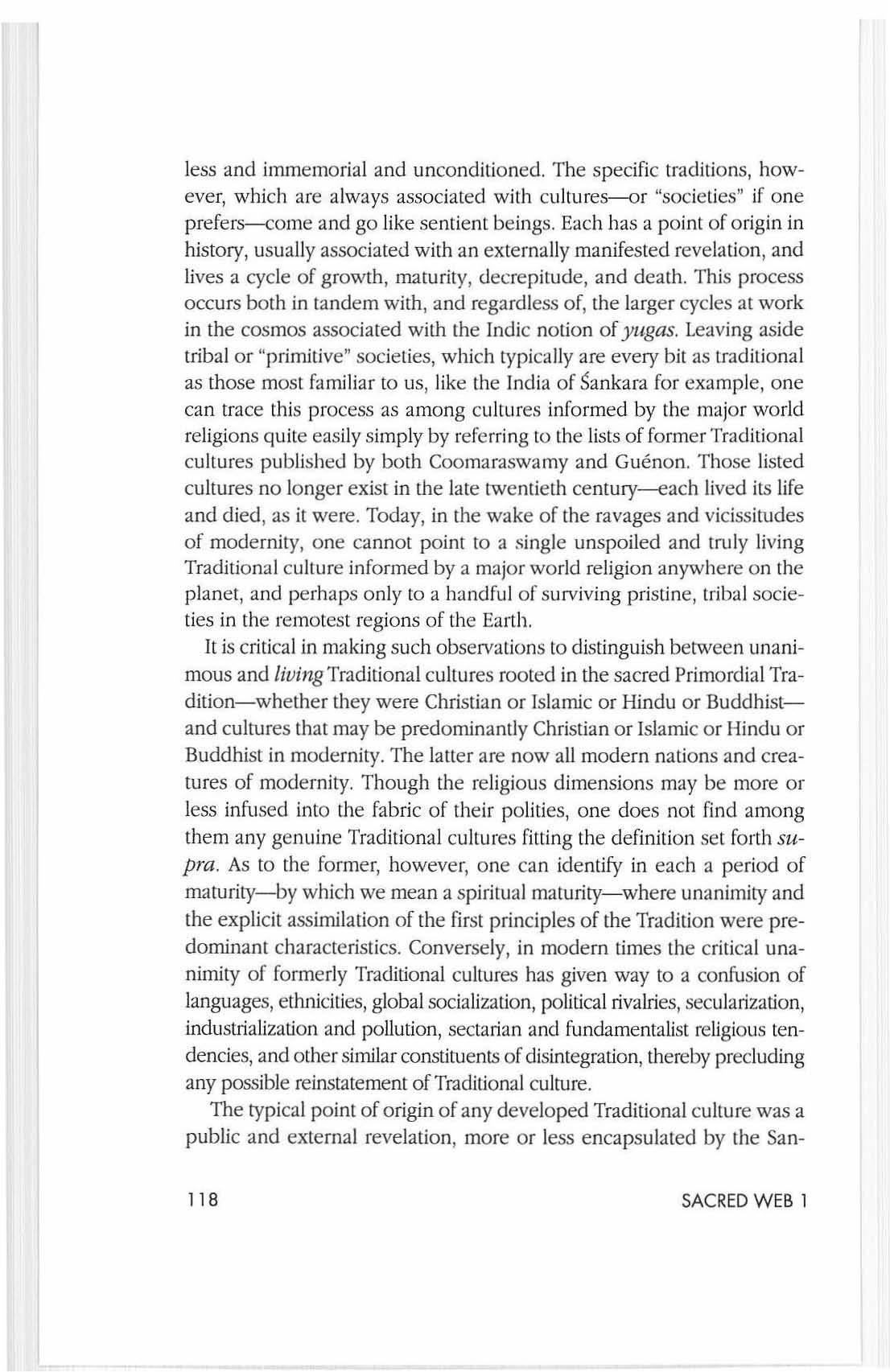
Each of these revelation s, which necessarily co ntain e d muhival e ncies of meaning ab initio , including the Primordial Tradition in essential form, resulted in creating an es tablished "religion." Reve la ti on an d the tradit ion that derives from it, as Frithjof Schuon has noted , b elong to the fo rmal order. More often than not , these revelat io ns c reated more than one re ligion , so at the outset major rifts and divi s ions occurred. One need look no further th an Mahayana and Hinayana , Eastern Orthodox and Wes tern Catholic , Sunni and Shi 'a, and so on. Funhennore, virtually all s uch public and e xt e rnal reve lations , within several centuries of their diss e mination, engendered numerous "heresi es," which were typically no more than hermeneutical differences on th e same, basic themes . Often th ese heresies were exterminated b y the dominant "orthodox" surv ivor of the early religiou s fo rmation wars, and so began what came to b e accepted by consensus as the orthodox re ligi o n . Thi s, in turn , became the acknow ledged keeper of th e line of "tran s mi ssio n " for regular initiation into holy orde rs or some mo nastic line d evoted to co ntemplation and active processes of spi ritual development We ha s ten to add here, how eve r, that regard less of the orthodoxy or pedigree of any such relig iOllS order, where true s piritual influence has cease d an d only dogma and empty ritual remain, no regular initiation c an be had, for in suc h c ircumstances the "transmission " or success io n becomes a parody , a holl ow gestu re , owing to th e d es uetude of spiritual influence While th e sta rting point of any such tra nsmiss ion was th e Prophet 's revelation , th e efficacy of the transmission depends on the surv ival of a spiritual in fluence, without which there exists on ly I;t lifeless form. The sp iritual influence of which we speak is , of course, ,[ loya l and reciproca l re lations hi p to the esoter ic or symbolic application of the re li gion-or revelationin question and , moreover, to those guardia ns of whom Guenon speaks in Le mi du monde as defenders of ce rtain sp iritu al centers that proximate the ex Jonte source of the Primordial Tradition. Where orthodoxy, as it too often does, takes the form of ecclesiastical bureaucracy, suc h spiritual influence itse lf is regard ed as heresy, as the case of Meister Eckhardt pe rfectly illu stra tes.
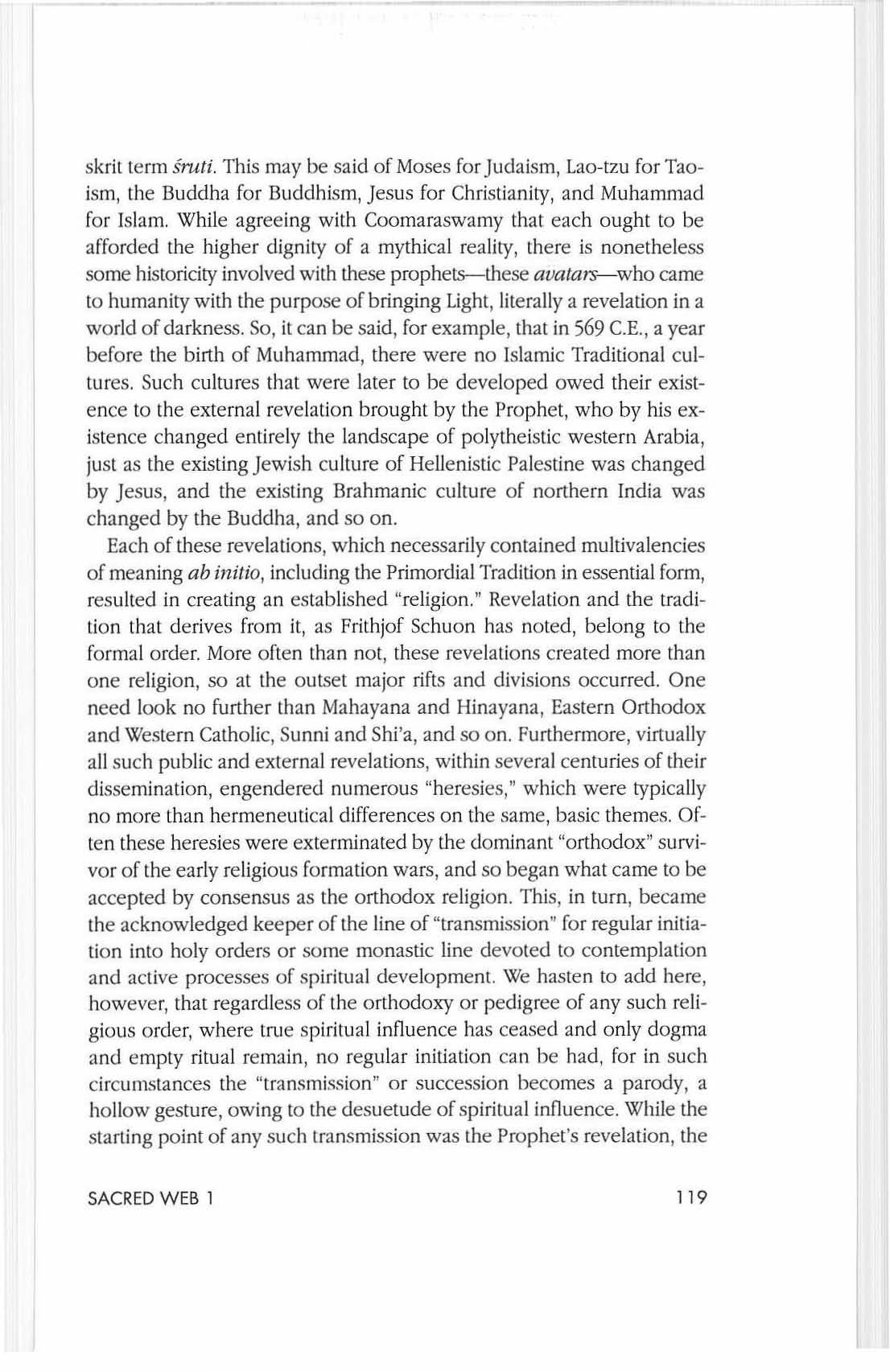
Relig ions, per se, tend to focu s o n a cu ltural communitas, which may be either con templative orders o r the active clergy and lai ty. Both are directly resultan t from the origina l and public revelation which gave them life. Each necessarily in volves interact ion with others, as against th e life of a cenobite, for example. In doing so, however, one inev itable res ult is the constant man ifesta tion of human foibles where people interact: competition, jealousy, power, required conformity, and the like. These a re , as Coomaraswamy would have sa id , man ifesta tion s of th e Outer Man. Contemplative orders and s piritual communities are b y no means e xempt from such problems. Moreover these foibles, while occas iona ll y evident in Traditional cultures, are as Michel Fou ca ult ha s amply shown exace rbat ed in th e religious in s tituti ons of modernity, where compet ition over contro l of both peop le and resources in the quest for power lead to cons tant and unremitting schisms of and splinter groups from larger denominations. Often, though not a lways, th e catalys t for such problems is the downfall or demise of a powerful and/or c hari s mati c leader revered by the sp iritu al community The communal c haos that derives from such an incident is an ind icium or even the measure of the absence of w hat was earlier referred to as "s piritua l influ ence." Whe re the laller exists, the former cannot.
In ternal Revelation
Internal revelation is that which occurs as an interna l process o f the spi ritual aspirant , where the mind and h eart intersect- refe rred to by both Coomaraswamy and Guenon as "intellection. " It is brought abou t by differing spiritual practices and techniques adapted to suit the individual cand id ate, but always involves the process of meditation . There are, moreover, varying degrees of internal revelation, ranging from basic intuiti ve insights into corres pondences to the state referred to by the Sa nskrit term samadhi. It is an achievement of th e seeke r alone , through his own so litary e fforts of practice and perseverence, and ha s nothing directl y to do with co mmunit as.
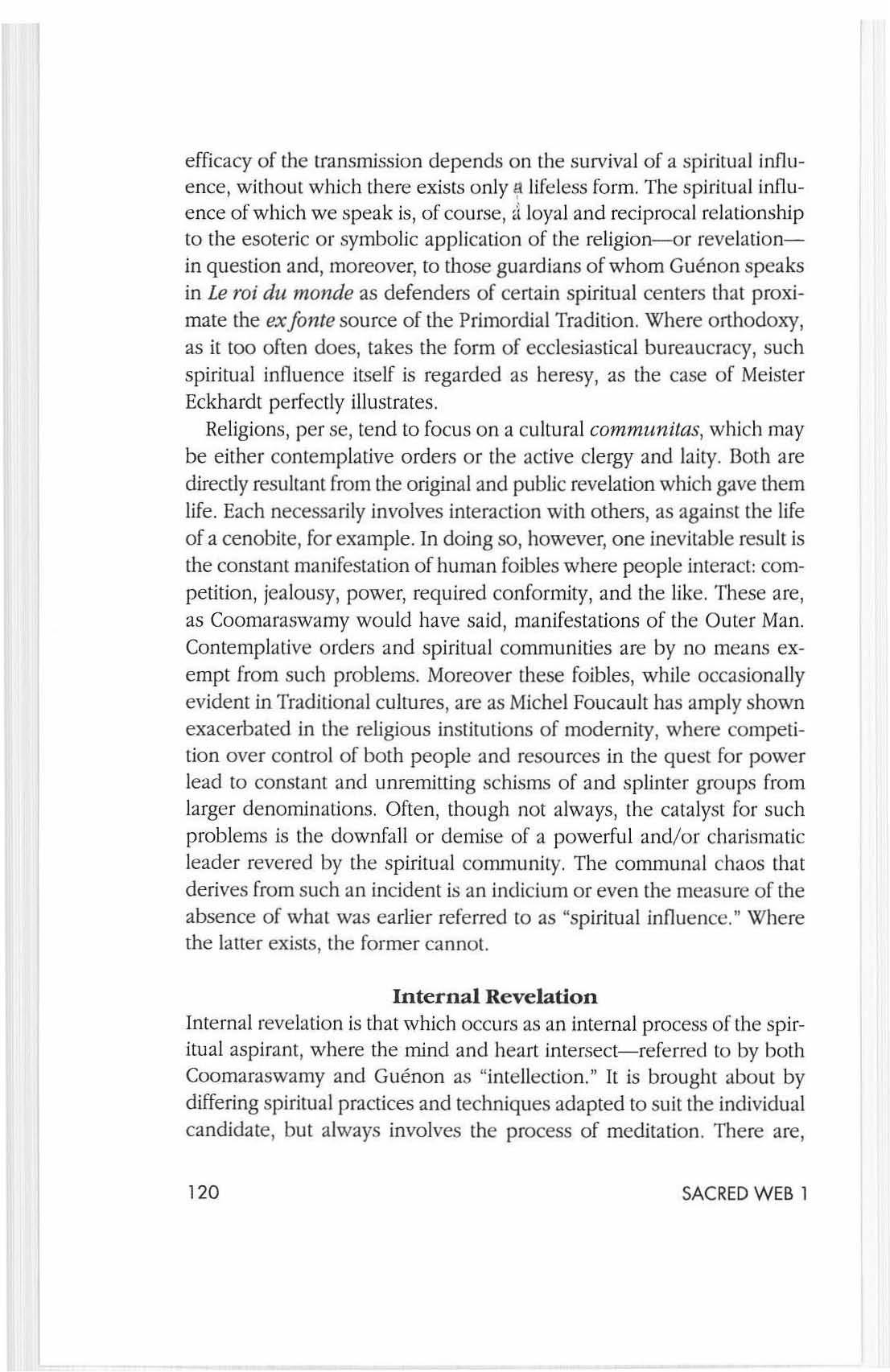
Certainly internal revelation can, and often does, occ ur within the milieu of some contemplative spiritual order in the physical realm under the long -term gu idance of a regularly initiated spi ritual teacher, but it ca n also occur in the life of an individual aspirant, living in phys ica l isolation from suc h an order, who by virtue of hi s daily practices and way of li fe routine ly accesses the li vi ng stream of reve l atory truth by w hich he guides hi s actions. The isolate may nm a greater ri sk of veering off co urse, so to speak, from the true sp iritual path than does the aspirant living within a bona fide spi rit ua l community, but so extens ive are th e reliable resources available today for the so litary aspirant's stud y and refl ec ti on for th e process of what Coomaraswamy refers to as "selfnaughting ," that this risk can be great ly minimized. Direction can also be had from the connectio ns made b y meditation and the process of internal revela tion . We do not assert here that such resources are an equal replacement for a bona fide teacherj rather, that where a person for w hatever reasons ca nnot avai l himself physically of life in a spiritual community , his cou rse ca n be chec ked ancl corrected by Traditional and oth er simil ar literat ure in addition to the daily sp iritual practices undertak en. Where no reasonable al te rn ative exists, it is undoubted ly better to tread the s piritua l path alone (ostensibl y) than not to tread it at all, despite w hatever risks may be attendant to th e quest. Neither sho uld one overlook, co nversely , the risk o f damage that could b e ca used by associating wilh what one believes in good faith to be a bona fide spiritu al commun ity and / or teacher, which / who in truth exists to serve and pre serve exclusively secu l ar ends by means of fraud or dominarion of the wi ll , and of which there appear to be so many in these days.
To repea t, int erna l reve lation occurs quite independent of o rth odox, cu lturally o riented re li gious communit ies based on some pr ior, historica l exte rnal reve lati on. It is an individual and not a collective phenomenon. It constitutes a direct apprehension of the first principles of the Tradition and all that is implicated thereby , without need of the manifest do ctrin es and teachings arising from the historical externa l reve lation, or established religion. It is the process of "re -coll ection" of what has been rem e mbered (Sanskrit smrti, i.e. "Tradition"), related to what in the Platonic context is refe rred to as anamnesis. The exte nt to which any aspirant in the process of internal revelation utili zes the exoteric symbolism and scriptural di sco urse of some world religion , some historical external reve lation, depends upon the experiences , backg round, and predilection of the aspirant. While the lise of such exoteric revelation via religious symbolism and sc ripture may be quite helpful to someparticularly to th ose born into and raised in that religi on-it is not an absolute and indispensable pre-condilion for direct apprehension of the first principles of the Tradition by those who possess the requisite ca pabilities. This points to perhaps the most salient practical difference between the exoteric and the esoteric, beyond simp ly th e exegesis of scripture based in any of the various historic revelations of the Word. It is not the phys ica l tea c her in this world that provides the pupil with th e w herewithal to achieve direct apprehension of the first prin ciples-internal revelation-via the deve loped gnosis (Sans krit prajiid ) or intellectual intuition. Rather, it is the pupil himself who inherently possesses this capability, and who alone can exercise it at will.
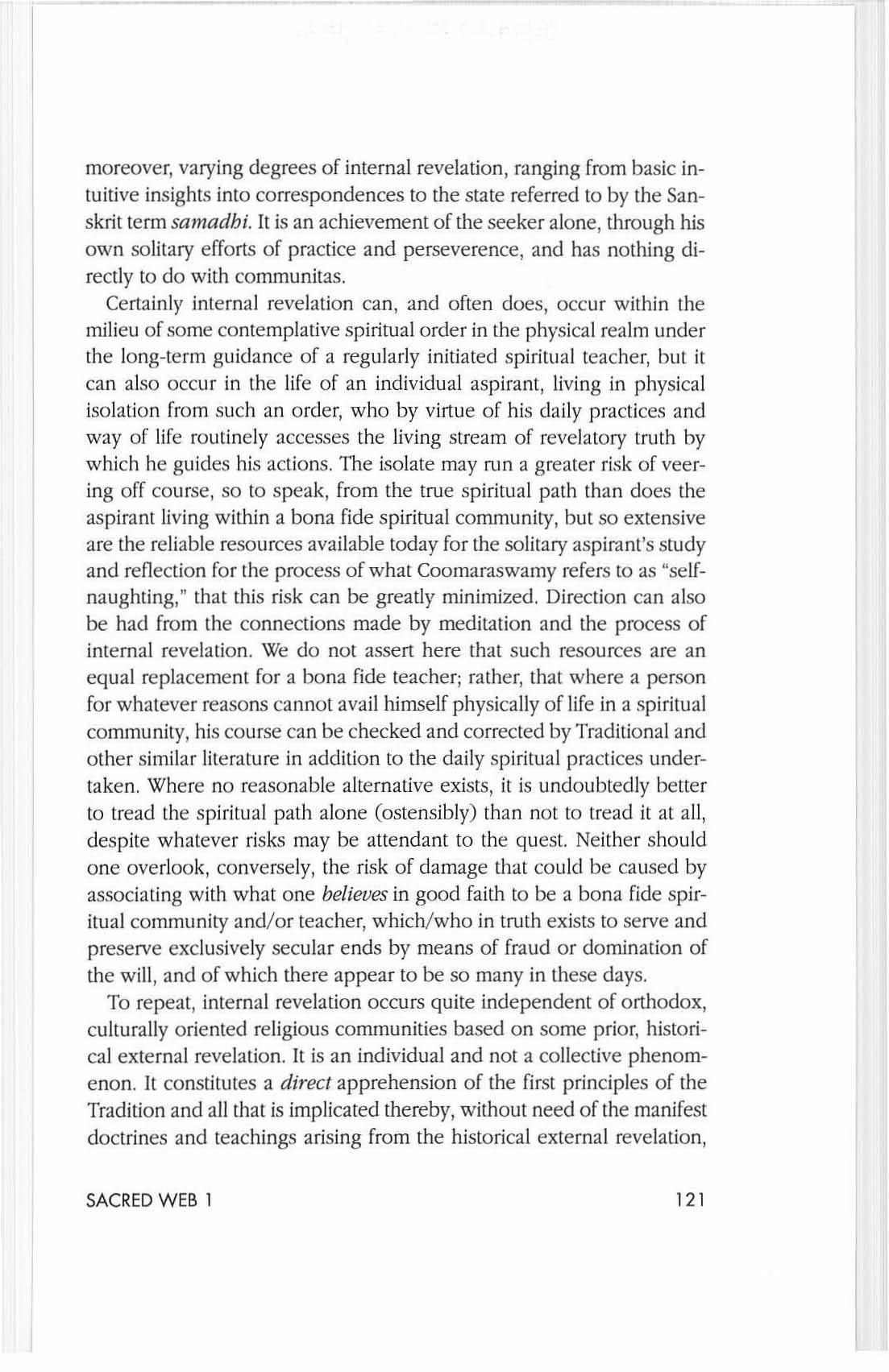
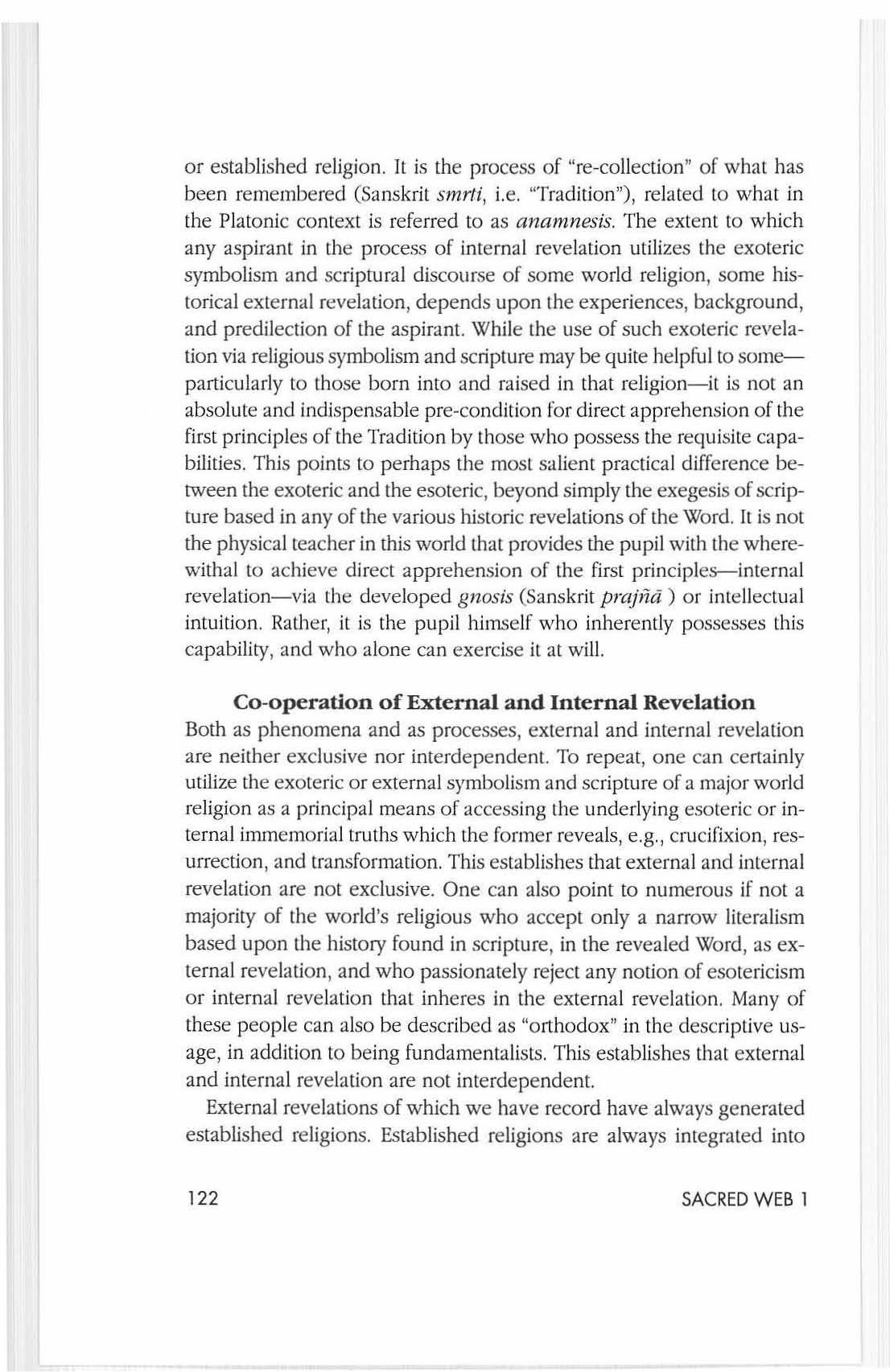
Co-operation of External and Internal Revelation
Both as phenomena and as processes, external and internal revelatio n are neith e r exclusive nor interdependen t. To repeat , one can ce rtainly utilize the exoter ic or external symbo li s m and sc riptur e of a major world religion as a prin Cipal means of ac cess ing the underlying eso teric or interna l immemo rial truths which the former reveals, e.g., crucifixion, resurrection, and transformation. This establis h es that external and internal revelation a re not exclusive. One can also point to numerous if not a majority of th e world's religious who accept only a narrow literalism based upon the history found in scripture, in the revealed Word, as external revelation , and who passionately reject any notion of eso tericism or interna l revelation that inheres in the external revelation. Many of thes e people can also be described as "o rthodox " in the descriplive usage, in add ili on to being fundamentalisls. Thi s estab li shes thal external and internal reve lation are not interdepe nd ent.
External revelations of which we have record have always generate d established religions. Established re ligio ns are always integraled into cultures, or soc ie ti esj they d o no t-cannot-exi s t ind e p e nd e ntl y o f c ultures. Co nsequ e ntl y. ex ternal re ve lation t hrou g h th e media o f estab lished religion s a re m ajoritaria n in the se nse that, with th e poss ibl e excep ti on of Buddhi s m , most mem bers or followers of a ce rtain re li gion- t he mass-base their pra c tice o f the religion almost excl usive ly o n the exte rnal revelat io n , and reject an y poss ibility of a n inte rnal revelation as anath e ma or heresy. This we would de sc ribe as th e normati ve concepti o n of external reve lati on vis a vis established, orthod o x religion.
The normativ e co n ce ption of Tradition is a synthesis of externa l and interna l revelation , the former serv ing as th e vehicle for th e latte r and se t within a c ultural expression that we hav e defined above as a Traditional c ultur e. A normative co nc e ption here, how e ve r, ha s neve r excluded th e possibility of an un affiliated cenob ite outs ide th e cu ltura l! o rth odox mainstream s u ccessfull y achie ving internal reve lation and initiation. (O ne wonders whether thi s no rmative c once pti on ca n exist at all in mod e rnity .) It is tru e , though , that all th e esse nti a l in gred ie nt s for facility o f revelation and initiation are institutionalized , as it were , in Traditional c uilur es, since any spiritual order-or voca ti o n a l guild, fo r th a t matte r--exis lin g in suc h a c ulture wou ld utili ze the existi ng relig io u s sy mb o li sm, sc ripture , and so forth as a basis of its liturgy and to c arry its worthy ca ndidat es thro ugh the initiation process. Il is important to e mpha size he re, as well, that thi s no rma ti ve co ncept ion of Traditi o n concern in g th e re lation o f ex ternal and internal rev ela ti o n must pres uppose for its efficacy a living Trad ition al c ulture in whi c h th e re li g io n find s expression, and not mere remnants of religi o n s existing within the setting of mo d e rn cu ltures and in which th e external reve latio n , if not th e s piritual influ e nce, ha s b ee n effective ly secularized.
Finally , w e co ns id e r the remaining alternative to (1) th e p ractice of an exclusive exte rn a l revelation, and (2) the practice o f a synt hes is of exte rn a l a nd interna l reve lation: namely , the practice of an exclus ive internal rev e lation. We are ce rt a inl y aware that so me in th e Traditional p e rs p ect ive refuse to acknowledge , as a matter of d og m a, that int e rnal reve lation and initiati o n (i.e., "sa lvation ") ca n exist o ut s ide an ort hod ox ex press io n o f one o f th e world's established religions. But we as k : g iven the age and breadth o f humanity , was there not interna l reve lati on and regular initiati o n on Earth in other plac e s and prior to the adv e nt of Muhammad' Then prior to Jesus' Then pri o r to the Buddha ' Th e n prior to Moses or Lao-1Zu or Zoroaste r? Then pri o r to any b earer of Light and revealer o f the Word? And wha t of th e huge p e rcenta ge o f hum a nity never exposed to any of the se ex te rn a l reve lations? To the first question posed we a n swer: if so, was not this interna l revelation and initiati on ultimately by direct an d unadorned access to th e s ui generis a n d immemorial first princip les of th e Tradition? And , if suc h was possible at any t ime before o r beyo nd or in betwee n these grea t movements of th e revea le d Word , is it nOl s imilarly possible today when everywhere we li ve w ith out benefit of access to sp iritu al orders in the physical world that are th e mse lves e le ments or constituents of living Traditi ona l c uhures? Th e s ho rt answe r must be th at it cannot be ot h erw ise: th e so urce of all external revelat io n is the Primordial Tradition, a nd where one has di rect access to th at so ur ce, w heth er ac hi eved w ith or w ith out the ai d of a te a che r in th is physical realm , th e ex ternal manifestations of the revea led Wo rd d o not const itute a requirement for eit her enlig ht enment o r initiation. Indeed, in th e modern world thi s may be th e only available path for a significant population of spi rit ual seekers who ha ve a ttain e d a co ns id e rabl e d eg ree of in sig ht and metaphysical acu ity.
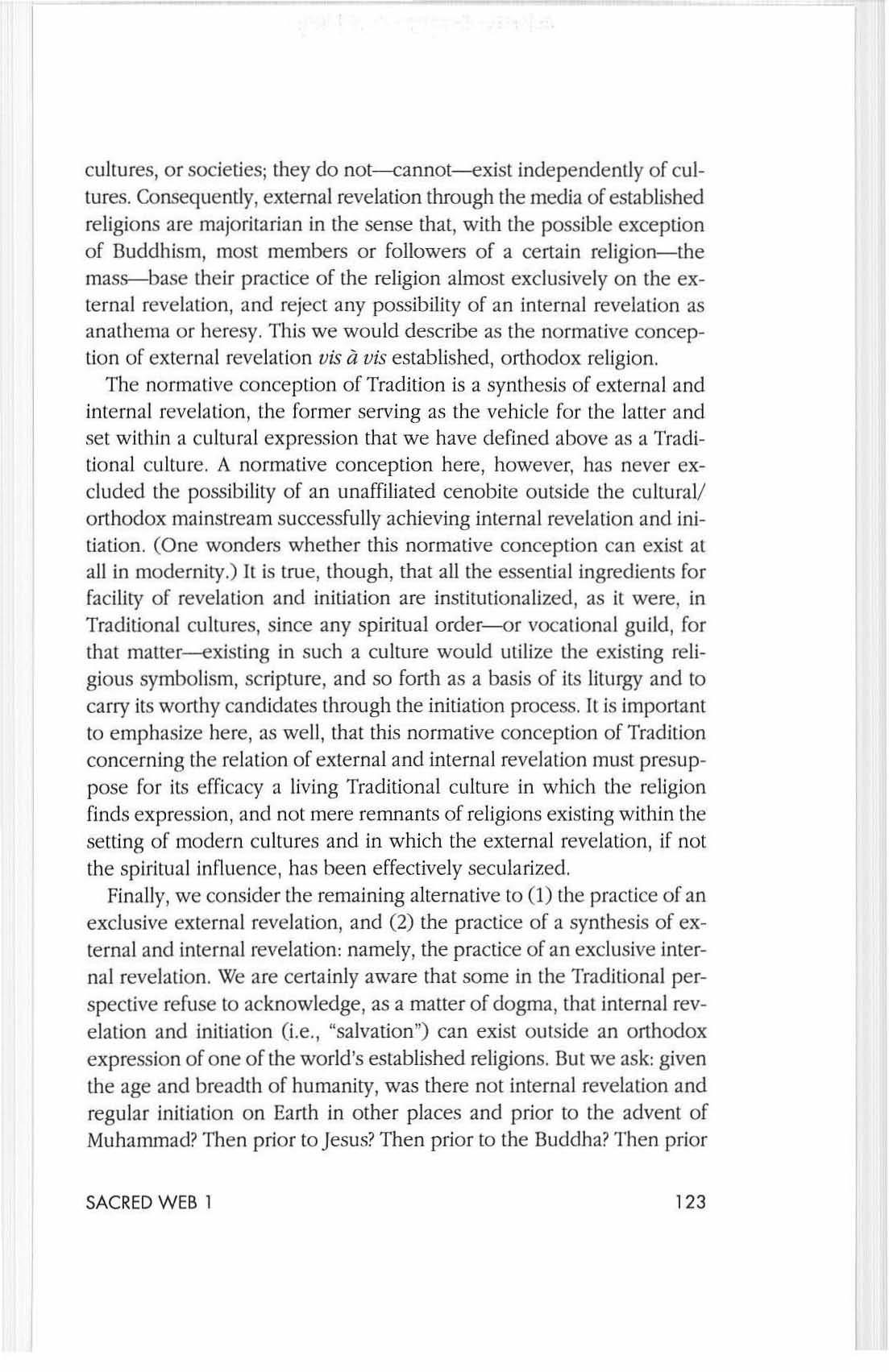
Cycle of Revelation and Orthodoxy
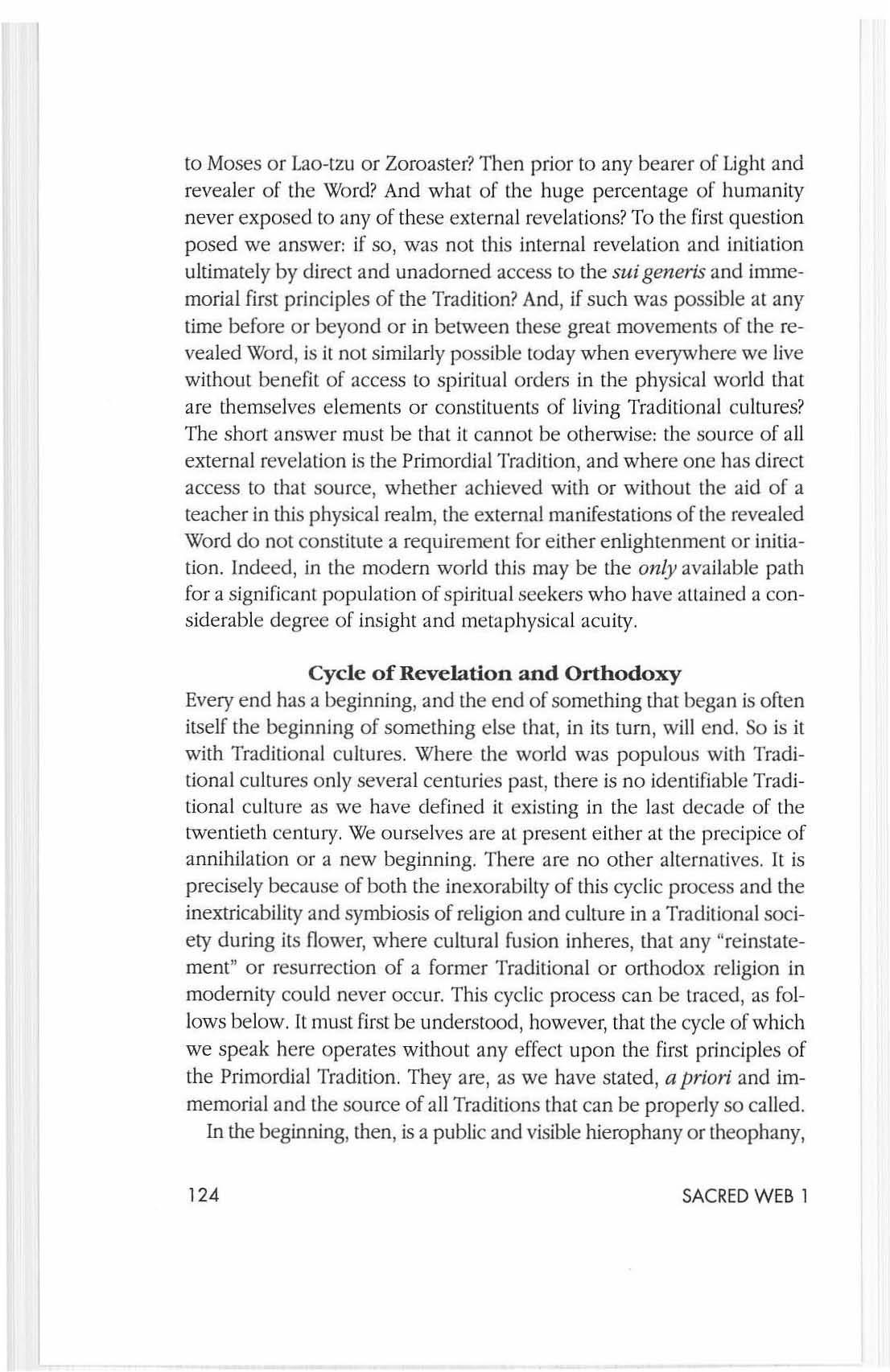
Every end has a beginn ing , and th e e nd of some thing th a t began is often itself the beginning of someth ing else tha t, in its turn , will end. So is it wi th Traditiona l cultures. Where the worl d was p o pul ous wit h Traditio n al cult u res on ly seve ral centuries past , there is no identifiable Traditional cu lt ure as we hav e defined il exis tin g in th e last deca d e of the twentieth ce ntu ry. We ourselves are a t presen t e ith e r at th e prec ipi ce of a nnihil atio n or a new b eg innin g. Th ere are no other alternatives. It is p rec isely because of both the inexorabilty o f thi s cyclic p rocess and the inextricability a nd symbios is of religion and cu lture in a Traditiona l society during it s flower, w h ere c ul tural fusion inheres, t ha l any "reinstatement " or resur rec ti on of a forme r Traditional o r orth odox relig ion in mod e rnit y cou ld never occ ur. This cyclic p rocess can be traced, as follows below. It m us t fir st be understood, howeve r, that th e cycle of w hi c h we speak he re o p erates without any effect upon the fir st prin cip les of th e Primordial Trad iti o n. They are, as we ha ve sta ted , a priori and immemorial and the source of a ll Trad it ions tha t can be properly so ca ll ed.
In th e beg in n in g , th en , is a public a nd v is ible hierophany or theop ha ny , or revela ti on, th a t occ urs in history and is of the ty p e d esc ri bed supra in which Pro ph ets bring to humanity a sta te ment of tru t h This truth is typ ica ll y co mmilled to sc ri pt u re a lmost immediat e ly, but normally con ta ins a n accompany in g ora l or myt hi c tradition as well. This revelation from an avatar begins th e direct lin e of t ran s mission, co nta ining an esoteric component, that is passed from teacher to teacher in thi s Trad ition and w hi c h survives as long as its stewards are meritor io us. This revelation, however, never tak es place in a cult ural va c uum , but rather comes to di s pla ce th e pri o r, prevailing religious world vi ew o f the reg ion an d era with o ne of its ow n
The seco nd pha se of thi s process is the gradu al d eve lo pme nt of o rthodoxy by means o f compe tition b etwee n th e num e ro us factions , sects , and groups of believe rs. This occurs at the sam e p ace as the me nt of t he cu ltura l wo rld view discussed in t he first phase. The process most familiar to wes te rn readers is early Chris ti anity and the me nt of Tra di t io nal Christia n c ultur es. It is diffi cult to mark the spot, hi sto ri ca ll y, for any o f th ese phases, but for thi s t he Rome of 51. Peter in th e fourth century C.E. o r the Byzantium of Co ns ta ntin e would be reaso nabl e cand id a tes. In th e Levant and the wider Me dit erra n ea n wo rld of p re-Nice ne Chri s tianity , mystery sc hools, Gn ost icism, an d "heresies n of a ll k inds abounded. Th is pa tt e rn is not too dissimHar from th e me nt of o th er wo rl d re li g io ns. From the fray , one-pe rh a p s th odoxies emerge, beco ming the "true" reli g ion. In th e Chri stia n setti ng , it w as Ro man an d Eastern Ch ristianity t h at cou ld arguab ly be ca lled orth odox in thi s se nse. And , in th e proce ss , t he other "co mp e t ito rs" were affirmative ly driven to extinction. In this regard , o ne wonders about th e s piritu a l d eve lopme nt , a d vanc e ment, and initiati o n of th ose p ropo ne nt s of un o rth odox G nos ti c is m , fo r exam ple , wh o in th eir s piritu a l prac ti ces used s uch para d oxo logica J texts as found at Nag Hammadi like tbe Thunder/ Per/ec t Mind , whose eso te ric meaning is both profound and ove rtl y clear. In deed, it is believed to be I renaeus , Bishop of Lyons in the 2nd cen tu ry C.E., w ho first u sed th e term "o rth o d ox" for h is ju xta p os iti on of th e " tru e religion ve rs us Gnosti cism and other contem p ora neo us esies in his prolifi c attac ks of their beliefs.
The third phase , fo ll ow in g the deve lo pme n t of an identifiable orthodo xy from th e initial revelatio n , is the s ub sequ e nt development of a Tradition a l c ultu re, as ha s bee n defined, built upon the un animous be li efs of the n ew o rthod oxy. Typica ll y, anel iro nically , a new to lera nce emerges with th e Traditional c ultur e In process, th e actual deve lopme nt of a Traditional c uit ure is more lik e ly to be a c h a ng e in an existing sacre d o r religious paradigm than an actua l c hange in the mater ia l culture of a region per se. For exam ple, lan guage and ma terial cu lture of those p laces into w hi c h Ch ri s tianity or Is lam o r Buddhi sm we re in troduced did not change overnight, but rather c hang e d g radua ll y with the infu s ion of th e symbols, a rt , and scriptu re of th e n ew re li g io n into th e existi ng cultural morphology. At firs t , an d without any centra l eccle siastica l co ntro l , the relig io n is ca rri ed into new location s a nd assumes th e n avor o f th e regio n . In th e case of Chri stia ni ty, fo r examp le, thi s is seen in th e Ethiopians, the Egypt ian Copts, the Sy ri a ns, th e Nesloria ns, and the Iri sh or Celtic Chri s ti ans , all of w hom , depending upon the poi nt in t im e be ing discussed , cou ld be defined as Tradition a l-as liv ing Traditional cu ltu res. T his, of co urse, raises an intere sting que s ti o n regarding o rth o doxy. Being all different s trains of Chri stianity , wou ld some or a ll of thes e be "orthodox " in the presc riptive sense, or is that a term reserved for Roman Catholicism and the Eastern c hurc h in th e de sc ripti ve se ns e? This would make for an in teresting study, bu t it is beyond the scope of the present ar ticle O ur p Oint is simply to identify the process whe re by co mplete fusion of t he ele ments of Trad itiona l c ulture occurs , wit h the most s igni ficant bei ng the in fus ion of th e sacred or religiou s e1eme m tha t , in it<; doctrin e, con tai ns th e first principl es of Trad it ion
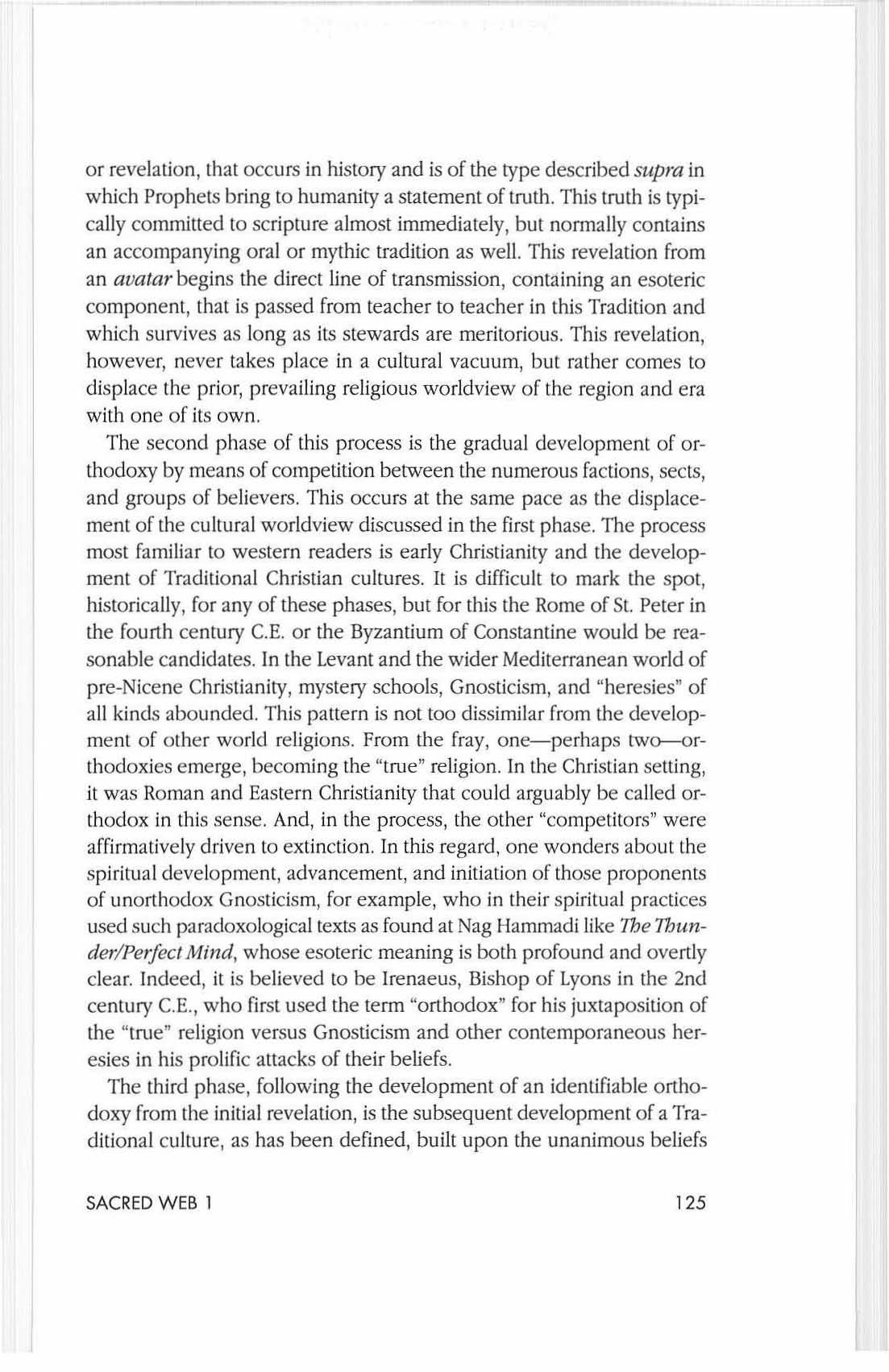
The fourth pha se of th e cycle, purs uant to our description here, is the flower or maturity of the Traditi ona l culture, where regular initiation is an incident of bot h (I) sp iritu a l o rd ers o f the religiou s orthodoxy and ( 2) vocat io n w it hin a u n a nimou s SOcie ty. It is a time in th e ex is tence of s uch a cu lt ure w he re the channels o f s p ir itu a l influen ce are o pen w ides t , and where 10ierance to a ll expressio ns of truth pre va il s. Cooma r aswamy s pent his adult life ex p lain in g the artifacts from s uch periods o f Tradit iona l cu ltur es, and thereby necessarily ex pl aini ng the philosophiaperennis. In such a sett in g does the te rm "reg ul ar" initiation have its d eares t mean ing , since bo th th e s piri tu al orders and th e vocation s derive the ir regularity , as it were, from the first principl es of Tradition w hi c h infor m and define t hem. By log ical necessity, this would also serve as th e s tandard o r measure o f regularity aga in st which to co mp a re a ll organiza ti ons, re ligious or otherwise , offe ri ng ini ti at io n
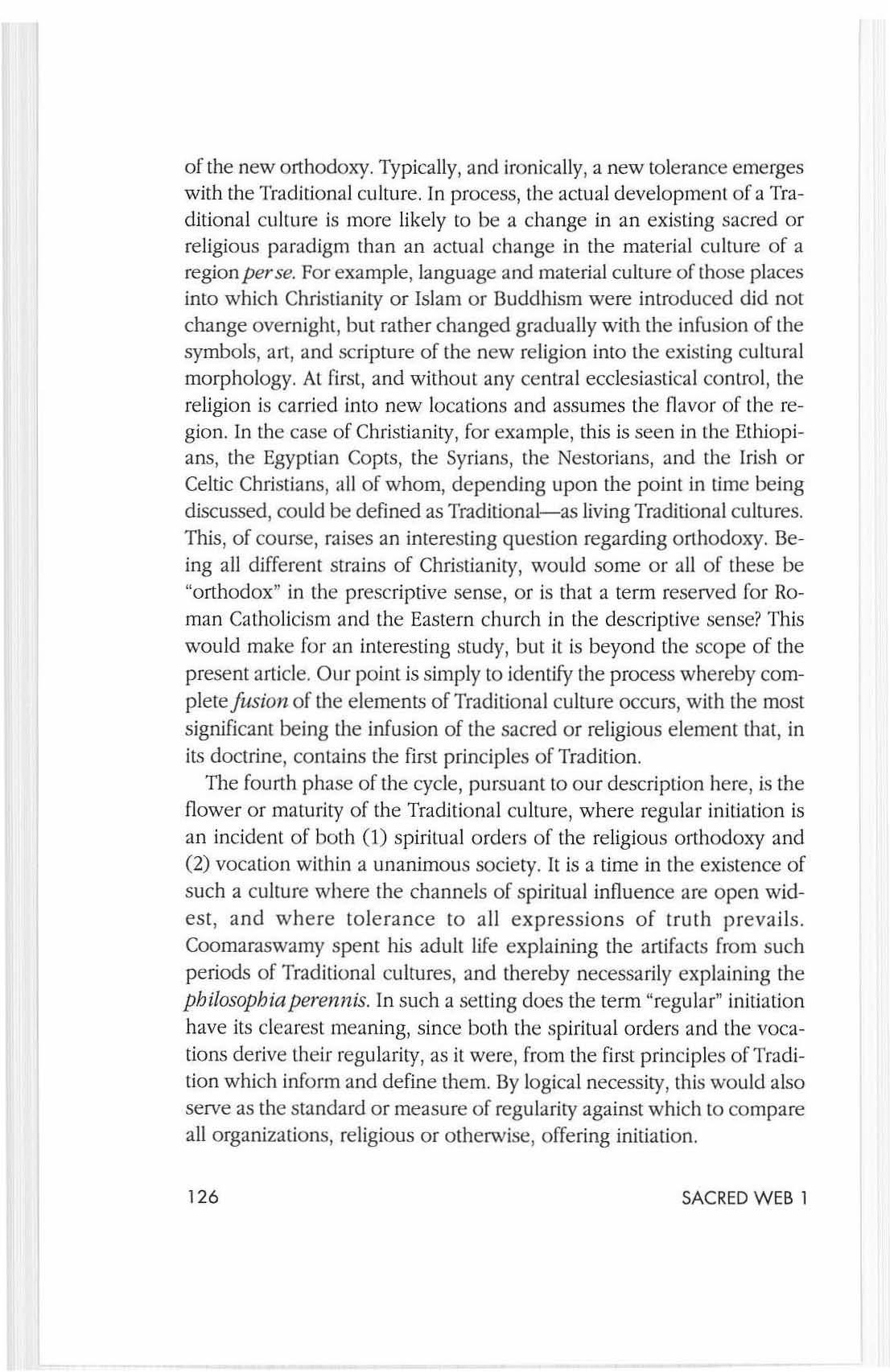
The fi ft h p hase marks the process o f d ecay and dyi ng. This ca n happen , as Gueno n and Coomaraswamy h ave shown , over a span of ce nturies in the West , o r virtually ove rnight as w ith th e A n asazi emp i re o f th e American Sou th west. Th e sy mpt oms of this degeneralion are, a mo ng others , a loss of th e "s piritu al influ ence d isc ussed above, and consequ ently the l oss of any ef ficacio u s line of tran smissio n of that i n flu ence and , a/01tiori, a cessat io n of any re g ularity in th e process of initi ation. On a more mund a ne leve l , th ese sym ptoms also typica ll y in clu d e the replacement of dogma for tru th ( Copernicu s b e ing a good example) a nd an eccles iastical in s titu tionalization of powe r (the post-R e fo rmati o n inquis ition being a good exam pl e) masquerading as ort h o d oxy. One dear irony appears in the e nd e av o r to clarify the use and mea ning of ort hodoxy in Traditio nal lit e rature: if orthodoxy is really stra ig ht thinking in its presc riptiv e usage, th e n it is orthodox to excoriate the abuses of "ort hodox " re li g io ns a nd religious institutions th at p lace dogma a nd blind authority above truth In a ny case, w he n, in th e life o f a religion an d th e c ult ure it dominates , d ogma a nd blind authority ha ve re pl aced the truth and/or th e searc h ro r truth , then d ecay is metastas ize d and death is immine nt.
\Ve n ow as k the imp o rtant qu estio n : what has survived of Traditional cu ltures a nd th e ir orthodox relig ions a n d religious institutions in the d ecade prior to th e adven t of the mill en n ium ? Do rea l ones co-exist in modernity along w ith c ul ts a nd fraternities of suicide and new "re li g ions " b ased o n ext ra te r res tr ial beings and cybe rn etics? Is regu la r initi a ti o n st ill ava il ab le th ro ugh th e media of organ izations, sp iritual o rd e rs, a nd s imilar bodies? Can a "traditi o nal o rganiza tion ," as Guenon writes, truly ex is t inde p e nd e ntly o f a living , brea thing Traditional cu lture o f which the mod e rn world ha s n o n e?
Revelat ion and Initiation Beyond Orthodoxy
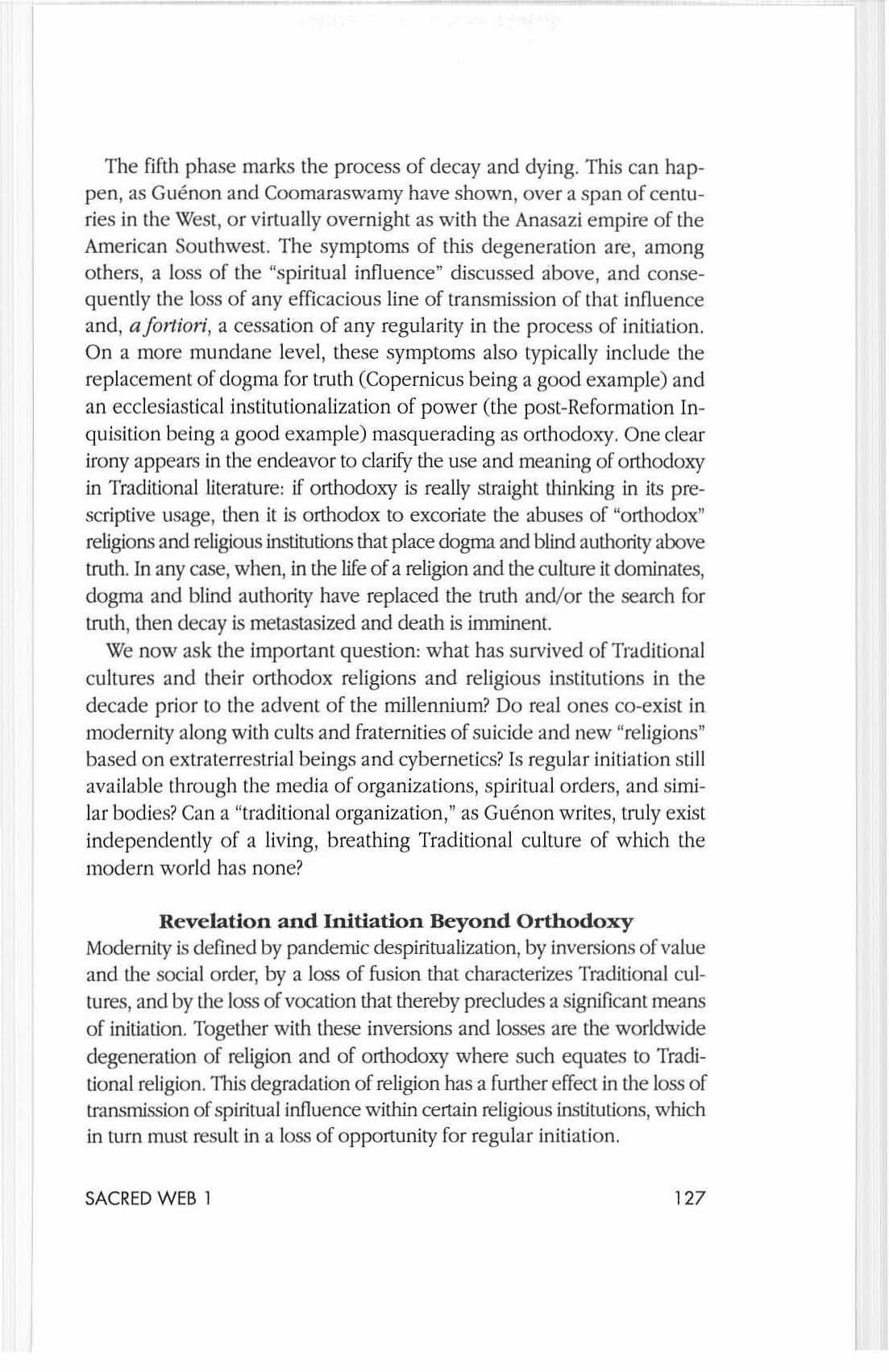
Modern ity is defined b y pandemic de s piritu a lization , b y in versions of value an d th e social oreler, by a loss of fusion that cha racte ri zes Traditional c ullures , and by th e loss of vocatio n m a t th e reby precludes a Sig nificant means of iniliati o n . Together with th ese in vers io ns a nd losses are th e worldwi d e d ege nera tion o f re ligion and of o rthodoxy where s uc h equates to Traditi ona l re li g ion. 11,i s degradation of religion has a furth er effect in the loss of transmission of spiri tual infl ue nce within certain relig ious institutions , which in turn must result in a loss of opportunity for regular in it iation.
SACRED WEB 1 12
Occurring simultaneously with all this is an undeniable and tremendous influx of esotericism, both of the pseudo-esoteric variety and, more significantly, of the bona fide variety. Of thi s latter, unparall eled numbers of people in the West, if not on a global scale, are demonstrably intuitive and esoterically sensitive. By this we mean that they are students of metaphysics , students of Traditional texts of all types, active in the disciplines of genuine yoga and medilation, and conscious, del iberate aspirants on the via contemplaliva. In short, there are considerab le numbers of these spiritual aspirants knocking on the gates of heaven, prep aring themselves for more li ght by means of initiat ion - regular initiation. In s heer numbers alone, together with its global scale, thi s is an undeniable fact that has seen no parallel in recorded history. While this may appear incongruous , we refer to Paul Ricoeur's observat ion that incongruity gives rise to thought. This thought is: It cannot be otherwise that means exist-means beyond those offered by remnant or th odox religious or spiritual orders no longe r connec ted with Traditional cultures-by which these aspirants can undergo regular initiation.
At the outset, we spoke of Guenon's use of the term "spi ritual influence." This term was used to describe sllch an influence emanating from a spiritual cenler and existing within "traditional organizations ," and preserved by mean s of transmission from teacher to teacher in these organizations . However, it should be remembered that sp iritual influences are not confined to organizations in this world, Traditional or othelWise, nor dispensed exclusively by spiritual teachers in the physical realm. Such spiritua l influences are available evel)'Where to anyone who, by virtue of his sacrificial strife on the inward journey, has won the right to ass imil ate them. Palmam qUi meruit feral. Whether this inward journey takes place under the guidance of a physical teacher in a residential , spiritual order, or whether it takes place independently of such a teacher or order by following the path on one 's own, the destinat ion is the same.
We have stated that the path of initi ation tread under the tutelage of a qualified teacher at the physical level is the easie r one, compared with the journey made alone. One must add to this that such qualified teachers, as rare as th ey arc, are of in estimable aid in this journey of th e initiate, but they are not indispensable. Such aid is available through another type of "Traditional o rganization " without campuses , and differing from the Traditional organ izations of which Guenon wrote and wh ich might be d esc ribed as physical brick-and-mortar Tibetan lama se ri es, or Chri sti an monaste ri es, or Hindu ashrams , or Sufi tariqas, w ith their l ama s, abbots, gurus, and s heikhs, and which may o r m ay not retain any s piritual inHu e nce. The "Traditional o rganization " of which we spea k h e re , if thi s is a prop e r description , is the source and not the recipi e nt of s piritual in flu ence and not bound to any particular c ulture o r external reve lat io n , Le., revealed religion. We have a lready identifj e d above Guenon's two major works on initiation. However, in so m e ways, Le roi du monde contains so me considerab ly more profound in sights into initiati o n and th e the ses proposed here than e ith er of them. Fo r exa mple , in d isc uss in g the re lationship between the Christian p ri es tho o d and the Orde r of M e1c hiz ede k , Guenon on page 51 of that boo k (E diti o n s Ga llim ard, 1958) states that "la participation a la tradition pe llt n 'et re pas toujours co nsc iente " ("participatio n in the Traditio n ma y not always b e conscious"). While Gu e non was describing th e s piritual influ e nce associat e d w ith Chri s tian pries ts celeb ratin g th e Eucharist, it mu s t necessaril y be tru e b y ex te ns ion t h at in o th e r circumstances o ne may part icipa te in the Traditi o n and not b e fully conscious o f it, regard less of c usto mary ritual exe rci ses. In fa c t, this phe nom enon app e ars to be cons id era bl y more widespread th an most would imagine as regard s th ose num e ro us s piritual aspirants, n o l direc tl y associated with any physical te ac h er o r o rd e r, who hav e made s ub s tantial progress despite the v ic iss itu des o f mod e rnity-o r mayb e because of the inner hi eros gamos through se lf-naughting and affirmative application o f the me an s to reac hing th e primordial state.
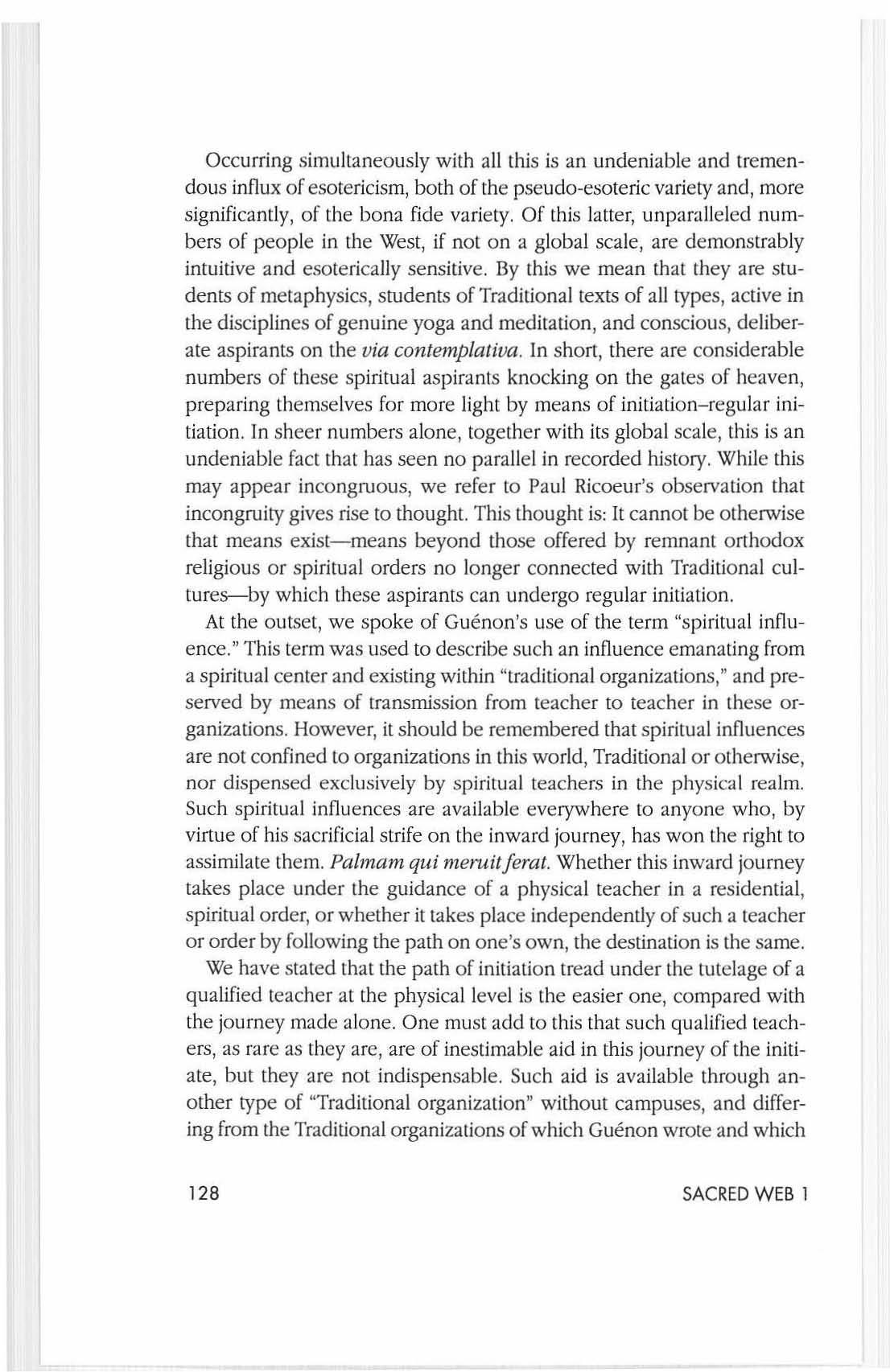
Co ns istent with thi s view, Coomaraswamy wrote in his essay e ntitl e d Manas that th e sec re t of initiation, or "de-mentation," ca n only be rea li zed by eac h o n e for himselfj a ll that can b e effected by initiatio n is th e communication of an impu ls e and an awakenin g of laten t possib iliti es ; the work Intls t be done by the initiate himself. .. " (e mpha s is added). Coomaraswamy did no t te ll us her e whether this work ne cessar il y had to b e don e und e r th e dire c t tu telage and in the phys ica l prese nce of a s piritual teac he r We belie ve he did not need to. Today we are mill e nnia from the la s t of th e great s piritual Prophets and th ei r o ri gi nal revelation s; we li ve in a mod e rn world where Traditional c ultures and va lu es no longer ex ist, and where orthodoxy in re vea le d religion divorced from Traditi o n ha s co me to mean secularized dogma. Traditional organ iza- tions or spiritua l orde rs no longer hav e any relation to Traditional cultures from whence they originated, and are themselves remnant s and iso lates where they still exist as bona fid e entities. The living streams of spiritual influence for which they once served as channels of transmission have , in the wake o f th e destruction of Hving Traditional c ultures, all but dried up. At the same time , we witness a virtual ex plosion of eSOlericism at the end of the twentieth ce ntury , a significant portion of which concerns il se lf with the higher metaphysics and the firs t principles of the primordial Tra dition . Taken together, one cannot but conclude that wherever one may find o ne se lf in life, and whenever the impulse manifests to follow the sp iritu a l path, o ne must go forth. To hesitate is to languish. In modernity there is no requirement to abandon one's situation to seek out a physical teacher in a residential , spiri tual order for th e purpose of undergoing initiation as was the customary cu ltural fo rm of a ll Tra ditional cultures, especia lly in light of the fact that under pre sent circums tances it is vai n to searc h for a teacher. For the se purposes, the truth is found within. Once found, and this co nn ect io n is established, the teacher will find the pupil and spiritual infllJenCe w ill flow , and regular initiation may follow.
